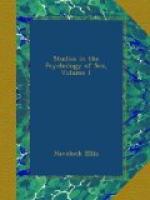[390] W. Thomas, “The Sexual Element in Sensibility,” Psychological Review, Jan., 1904.
[391] System der gerichtlichen Psychologie, second edition, 1842, pp. 266-68; and more at length in his Allgemeine Diagnostik der psychischen Krankheiten, second edition, 1832, pp. 247-51.
[392] Handboek van de Pathologie en Therapie der Krankzinnigheid, 1863, p. 139 of English edition.
[393] Manuel pratique de Medecine mentale, 1892, p. 31.
[394] Text-book of Mental Diseases, p. 393.
[395] G.H. Savage, Insanity, 1886.
[396] American Journal of Insanity, April, 1895.
[397] “Des Psychoses Religieuses,” Archives de Neurologie, 1897.
[398] “Erotopathia,” Alienist and Neurologist, October, 1893.
[399] Reference may be specially made to the interesting chapter on “Delire Religieux” in Icard’s La Femme pendant la Periode Menstruelle, pp. 211-234.
[400] Psychopathia Sexualis, eighth edition, pp. 8 and 11. Gannouchkine ("La Volupte, la Cruante et la Religion,” Annales Medico-Psychologique, 1901, No. 3) has further emphasized this convertibility.
[401] E. Murisier, “Le Sentiment Religieux dans l’Extase,” Revue Philosophique, November, 1898. Starbuck, again (Psychology of Religion, Chapter XXX), in a brief discussion of this point, concludes that “the sexual life, although it has left its impress on fully developed religion, seems to have originally given the psychic impulse which called out the latent possibilities of developments, rather than to have furnished the raw material out of which religion was constructed.”
[402] “Una Santa,” Archivio di Psichiatria, vol. xix, pp. 438-47, 1898.
[403] With regard to the sexual element in the worship of the Virgin, see “Ueber den Mariencultus,” L. Feuerbach’s Sammtliche Werke, Bd. I, 1846.
[404] Published for the first time (with a Preface by Charcot) in a volume of the Bibliotheque Diabolique, 1886.
[405] The Hebrews, themselves, used the same word for the love of woman and for the Divine love (Northcote, Christianity and Sex Problems, p. 140).
[406] Thus, in St. Theresa’s Conceptos del Amor de Dios, the words “Beseme con el beso de su boca,”—Let him kiss me with the kisses of his mouth—constantly recur.
[407] Acta Sanctorum, May 12th.
[408] Leuba and Montmorand, in their valuable and detailed studies of Christian mysticism, though differing from each other in some points, are agreed on this; H. Leuba, “Les Tendances Religieuses chez les Mystiques Chretiens,” Revue Philosophique, July and Nov., 1902; B. de Montmorand, “L’Erotomanie des Mystiques Chretiens,” id., Oct., 1903. Montmorand points out that physical sexual manifestations were sometimes recognized and frankly accepted by mystics. He quotes from Molinos, a passage in which the famous Spanish quietist states that there is no reason to be disquieted even at the occurrence of pollutions or masturbation, et etiam pejora.




